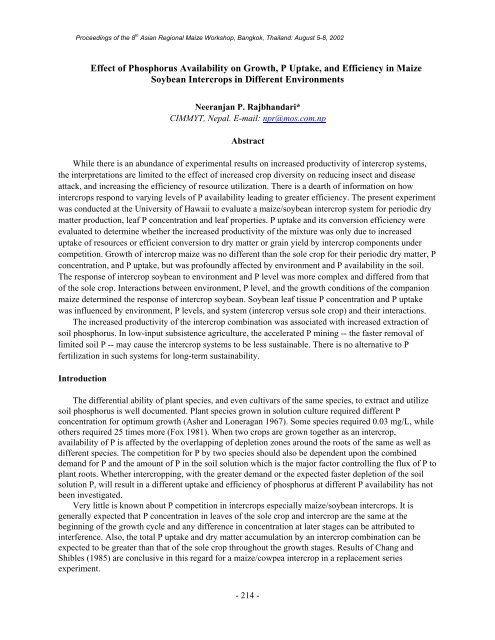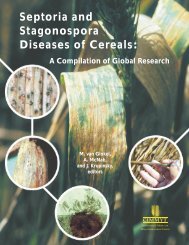Section 3 (Crop Management)
Section 3 (Crop Management)
Section 3 (Crop Management)
Create successful ePaper yourself
Turn your PDF publications into a flip-book with our unique Google optimized e-Paper software.
Proceedings of the 8 th Asian Regional Maize Workshop, Bangkok, Thailand: August 5-8, 2002<br />
Effect of Phosphorus Availability on Growth, P Uptake, and Efficiency in Maize<br />
Soybean Intercrops in Different Environments<br />
Neeranjan P. Rajbhandari*<br />
CIMMYT, Nepal. E-mail: npr@mos.com.np<br />
Abstract<br />
While there is an abundance of experimental results on increased productivity of intercrop systems,<br />
the interpretations are limited to the effect of increased crop diversity on reducing insect and disease<br />
attack, and increasing the efficiency of resource utilization. There is a dearth of information on how<br />
intercrops respond to varying levels of P availability leading to greater efficiency. The present experiment<br />
was conducted at the University of Hawaii to evaluate a maize/soybean intercrop system for periodic dry<br />
matter production, leaf P concentration and leaf properties. P uptake and its conversion efficiency were<br />
evaluated to determine whether the increased productivity of the mixture was only due to increased<br />
uptake of resources or efficient conversion to dry matter or grain yield by intercrop components under<br />
competition. Growth of intercrop maize was no different than the sole crop for their periodic dry matter, P<br />
concentration, and P uptake, but was profoundly affected by environment and P availability in the soil.<br />
The response of intercrop soybean to environment and P level was more complex and differed from that<br />
of the sole crop. Interactions between environment, P level, and the growth conditions of the companion<br />
maize determined the response of intercrop soybean. Soybean leaf tissue P concentration and P uptake<br />
was influenced by environment, P levels, and system (intercrop versus sole crop) and their interactions.<br />
The increased productivity of the intercrop combination was associated with increased extraction of<br />
soil phosphorus. In low-input subsistence agriculture, the accelerated P mining -- the faster removal of<br />
limited soil P -- may cause the intercrop systems to be less sustainable. There is no alternative to P<br />
fertilization in such systems for long-term sustainability.<br />
Introduction<br />
The differential ability of plant species, and even cultivars of the same species, to extract and utilize<br />
soil phosphorus is well documented. Plant species grown in solution culture required different P<br />
concentration for optimum growth (Asher and Loneragan 1967). Some species required 0.03 mg/L, while<br />
others required 25 times more (Fox 1981). When two crops are grown together as an intercrop,<br />
availability of P is affected by the overlapping of depletion zones around the roots of the same as well as<br />
different species. The competition for P by two species should also be dependent upon the combined<br />
demand for P and the amount of P in the soil solution which is the major factor controlling the flux of P to<br />
plant roots. Whether intercropping, with the greater demand or the expected faster depletion of the soil<br />
solution P, will result in a different uptake and efficiency of phosphorus at different P availability has not<br />
been investigated.<br />
Very little is known about P competition in intercrops especially maize/soybean intercrops. It is<br />
generally expected that P concentration in leaves of the sole crop and intercrop are the same at the<br />
beginning of the growth cycle and any difference in concentration at later stages can be attributed to<br />
interference. Also, the total P uptake and dry matter accumulation by an intercrop combination can be<br />
expected to be greater than that of the sole crop throughout the growth stages. Results of Chang and<br />
Shibles (1985) are conclusive in this regard for a maize/cowpea intercrop in a replacement series<br />
experiment.<br />
- 214 -









